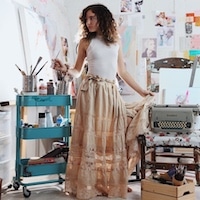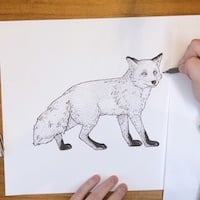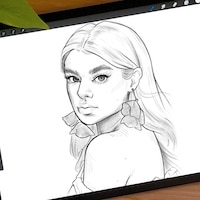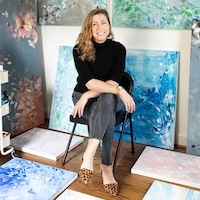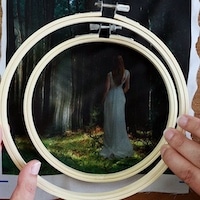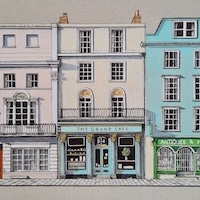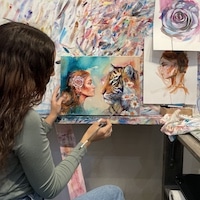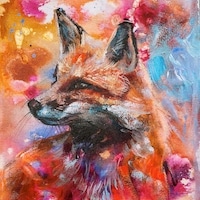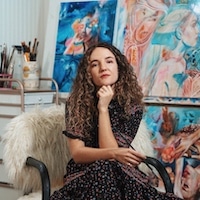
“La voz que se esparció entre las montañas,” 2024, oil on canvas, 59 x 59 in
In the work of artist Angel Cammen, there's much more to a self-portrait than the likeness of the painter. Born and raised in Northern Mexico, a stronghold of conservative values, Cammen's paintings are charged with a bubbling symbolism. On one hand, they are spaces of introspection, carved out by the artist himself. On the other hand, they are joyous statements that he is thriving and going to be loudly himself—whether society likes it or not.
Cammen's mother passed away when he was only eight years old. Prompted by the itch to reach out to her and tell her what he's up to, the artist often turns his canvases into missives. He encloses an image of how he looks today and also shares important news, such as moving in with a partner, or even the simple, mundane musings that cross our minds. In this way, art is the one and only communication channel with the great beyond.
For all their autobiographical load, Cammen's paintings hold space for the queer community. His compositions often serve as a mirror; whether the viewer is scared to look or loves the reflection, that's up to every individual. But they also offer acknowledgement and a beautiful, colorful space for those in need of a place to be seen, accepted, and understood.
Cammen lists Frida Kahlo and Diego Rivera as some of his main influences, tending a bridge to the past and present in Mexican art. The Kahlo effect can be seen in the head-on self-portraiture, taking up space through boastful colors and motifs that fill the composition with meaning, while the artist also channels the nonconformity battle cry of mid-century Mexican muralists.
We had a chance to talk to Cammen about his beginnings, his creative process, and the emotional core of his work. Read on for My Modern Met's exclusive interview.

“Los hombres comen chile,” 2024, oil on canvas, 39.3 x 51.2 in
How did you get started in painting?
My start in painting had to do with my fascination for color theory, but I have another explanation that I like better. When I was six or seven years old, I saw a painting in the parish of San Gregorio Magno, in my grandparents' town in Zacatecas, Mexico, and it made a great impression on me. I was very curious to know how someone could create something like that, and it is something very beautiful because 20 years later, I still have the same curiosity I had as a child. Curiosity can take you far.

“El sillón rojo,” 2023, oil on canvas, 39.3 x 39.3 in
How did you develop your personal style?
I remember hearing an interview where an artist (whose name I don't remember) said: “Repetition creates recognition”, and that idea has been fundamental for me in the last few years. It is very important to me that my work is easily recognizable. I think my self-portraits, compositions, color palette, and some elements have helped me develop my personal style.
Is there any style that you feel particularly influenced by?
Yes, I am particularly influenced by Mexican figurative painting, which manages to fuse a strong emotional charge with social, historical and cultural themes. I am inspired by artists such as Julio Galán, Frida Kahlo, Diego Rivera, to mention a few, who have used the human figure as a means of symbolic and narrative expression. I am interested in how the figurative in Mexican art transcends representation to communicate, question, and connect with identity.

“El impostor (yo no pagué por esto),” 2023, oil on canvas, 51.2 x 39.3 in
Your work seems to focus on memory, identity, and sexuality. What role do these motifs and themes play in your practice?
Yes, these themes are at the center of my work because they are fundamental axes of the human experience and also of my personal history. Memory allows me to explore the intimate, the familiar, and how the past shapes our perception of the present. Identity is a constantly changing construction, influenced by gender and emotional relationships, and I am interested in representing it from its tensions and contradictions. Sexuality is a vital, complex, and political force, not only as desire, but also as a space of vulnerability, affirmation and resistance. Together, these themes allow me to work from the autobiographical towards the collective.

“El irremediable dolor, “2024, oil on canvas, 59 x 86.6 in.
What's your creative process like?
A key part of my process is research and reading, which help me contextualize and delve deeper into the topics I address. I work with family photographic archives as a starting point, from which I find images that inspire me with ideas and emotions. I'm not interested in reproducing photographs as is; I prefer to create compositions from multiple images, like a visual collage that blends time, bodies, and gestures. This way, I construct new images.
Are the people in your paintings based on real people, or are they variations of the same character?
They usually are self-portraits, although sometimes I am joined by others. I have depicted my relationship in painting; in some other works, I have painted my mother, father, or grandmother. For me, the theme of memory is important because my mother passed away when I was eight years old, and I don't have many memories or photographs of her. Sometimes I repeat certain bodies or postures as a way of insisting on a sensation or a memory. In that sense, it could be said that they are not portraits, but constructed presences, variations of the same figure that is born from the real, but they inhabit an emotional, symbolic space, speaking of my mother.

“Mandarína,” 2024, mixed media (pastel oils on canvas), 27.5 x 27.5 in
What do you hope people will take away from your art?
I hope that those who approach my work can feel something genuine, that it awakens a memory, a forgotten emotion, a question about who they are or where they come from. I work from the intimate, from what hurts me, moves me, or makes me doubt, and I would like that honesty to be reflected in the viewer's experience. I do not seek to give answers, but to share a quest.

Courtesy of Clarisa Navarro










